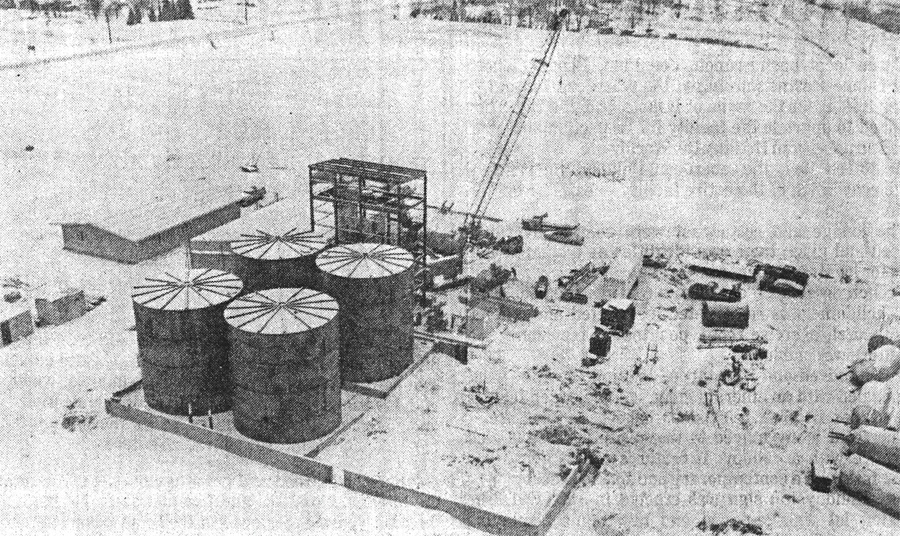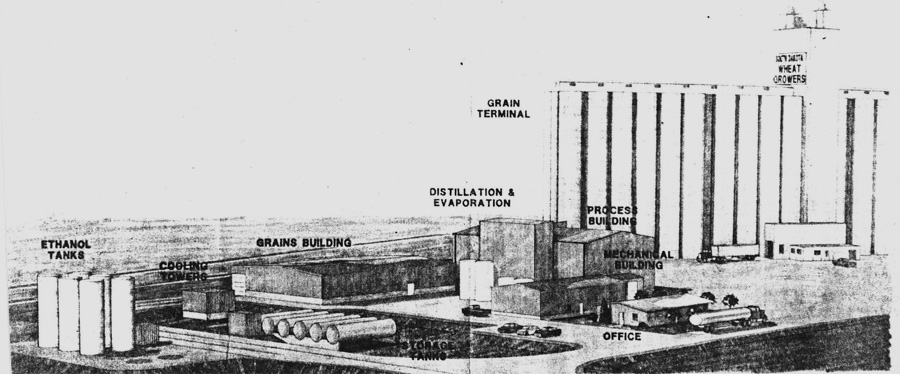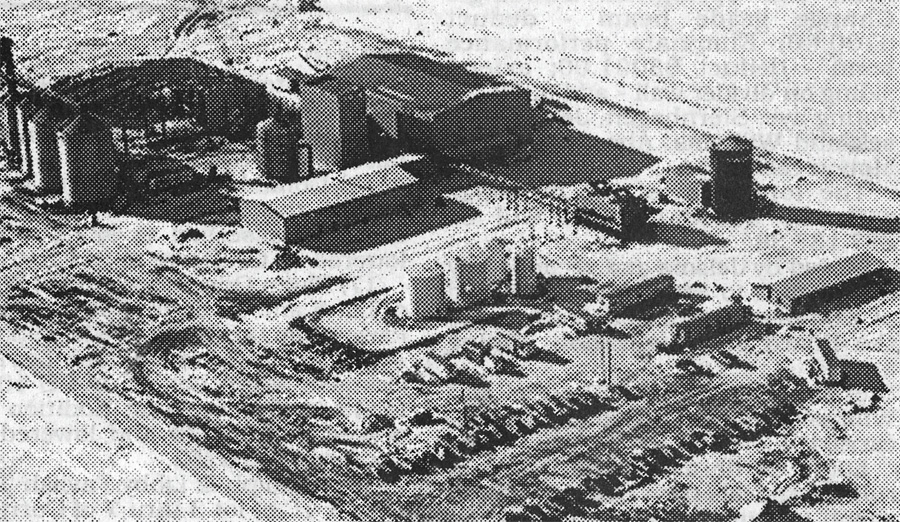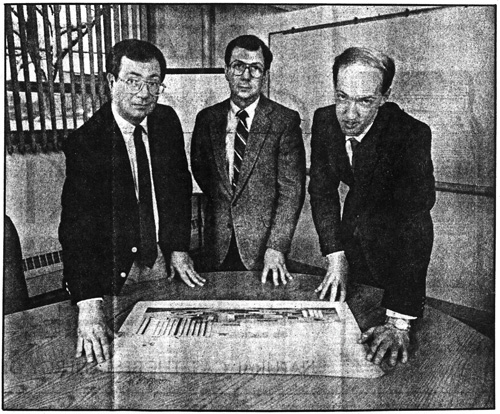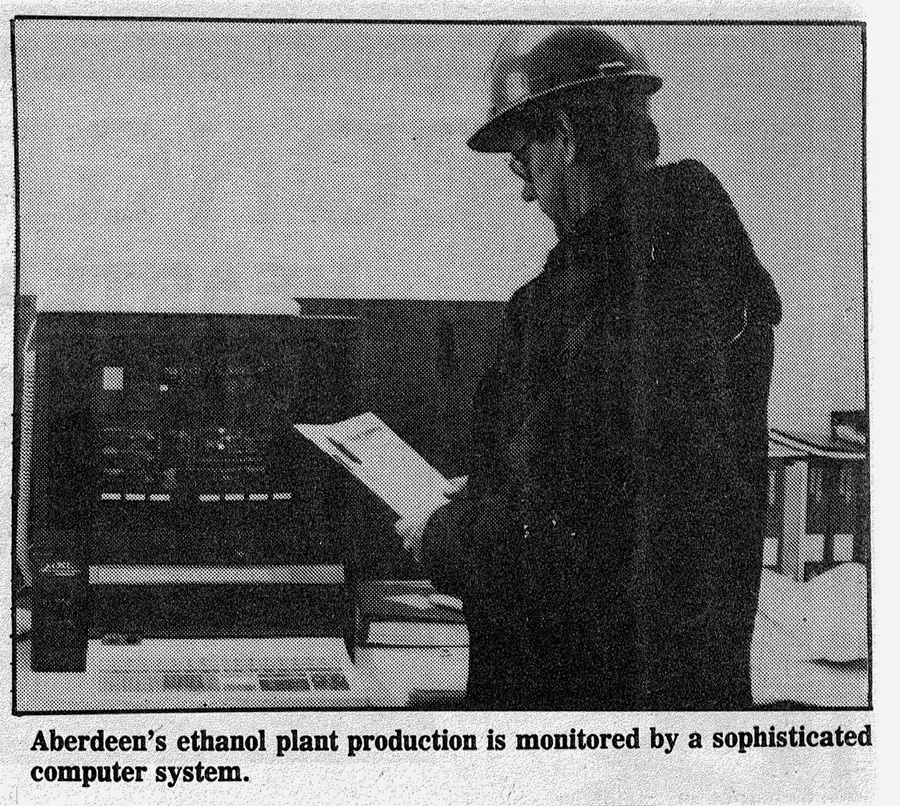FEATURED WINTER 2016 ISSUE
The History of POET: Bold Transformation, a POET Tradition
Success drives expansion and the development of the POET business model.
As one of the world’s largest ethanol producers, POET now has 28 biorefineries and a multitude of supporting companies including POET Design and Construction, POET Plant Management, POET
Nutrition, POET Ethanol Products, POET Grain, POET Research and several more.
At the Project LIBERTY dedication in 2014, POET’s joint venture with Royal DSM was heralded as a transforming event. It would help lead the U.S. into a post-fossil fuel age.
This is the POET of today. But at POET, old hands had seen a version of this transformation before.
More than two decades ago, POET began with a bold ethanol start-up in Scotland, SD and underwent a metamorphosis that launched a biofuels empire.
To recap POET’s history, the Broin family in the early 1980s began making ethanol at a small scale plant of their own design on their southeastern Minnesota farm and selling it in the area. In 1987 they parlayed this into purchasing and resurrecting a failed one-million-gallon ethanol production facility in Scotland, SD. After expanding it several times, the Broins saw the Scotland plant grow into a thriving enterprise. As such, it stood out in the sparse universe of an ethanol industry battered by hard times in agriculture in the 1970s and 1980s.
State per gallon economic incentives for ethanol production and the emergence of ethanol as a motor fuel oxygenate were lifelines for the struggling industry. The Broins chose to lobby for these programs and their funding, along with other interested parties, and then were able to use them to grow their business.
The Broin’s Scotland venture was a notable business success story, albeit on a modest scale. And other companies saw this success.
REPLICATING SUCCESS
A couple of years after Broin Enterprises began making ethanol at Scotland, representatives from Farmland Industries approached general manager Jeff Broin, who was barely in his mid-twenties.
“We were in the process of expanding Scotland from one to three million gallons,” Jeff says. “Two gentlemen from Farmland Industries, business development people, asked for a tour. They said ‘Is there money in this game?’ I said ‘sure there is.’”
The statement should be chiseled into a POET monument. It was the start of everything that followed.
Farmland Industries was at its peak, the largest agricultural cooperative in North America, involved in crop and livestock production, petroleum refining, fertilizer manufacturing and marketing and shipping agricultural products. When it liquated throughout 2002-2004, it listed $2.7 billion in assets.
After Broin shared financial information from the Scotland plant, Farmland Industries, in a partnership with South Dakota Wheat Growers Association, asked Broin to build them an ethanol plant in Aberdeen, SD with the same low cost methods they had used in the past.
For the reconstruction and expansions of the Scotland plant, Jeff Broin led the management of the business and staff, secured financing and handled state and federal politics while his brother Rob led the design and construction of the plant.
Following the original Scotland renovation, Rob had returned to farming with his father, Lowell in Minnesota. But when Farmland Industries approached Jeff about building an ethanol plant in Aberdeen, Jeff approached Rob and the Broin family about creating a design/build company called Broin and Associates. Jeff then asked if Rob would leave the farm permanently and join the new entity. Jeff told Rob, “I believe we can build a lot of plants in the future.”
Put that on the monument, too.
In 1989, Jeff became the CEO and Rob became President of the newly formed Broin and Associates. By 2006, they had led the planning and fundraising, development, design, construction and start-up of 26 ethanol plants. For the first one in Aberdeen, Rob said, “we really didn’t completely know everything we were getting into,” he acknowledges. “We were stepping out in faith that we would find a way to make it all work.”
They used computer-aided design for the first time. “That was a big deal in those days,” Rob remembers, and Farmland enlisted a general engineering firm to review the drawings since the Broins were new to the business of building for others.
“That was good for them and good for us. It raised the bar for us. We stepped up to a higher standard of engineering we hadn’t dealt with before,” Rob says.
While Rob completed engineering on the four-million-gallon plant for Aberdeen, Jeff negotiated the contracts with Farmland Industries and the South Dakota Wheat Growers, fine-tuned budgets, managed board relations and secured some of the equipment. The first plant begged a compelling question: what do you charge someone to build them an ethanol plant?
“We had to assure it was profitable or we would be out of business,” Jeff says. “Rob and I worked together to come up with a budget. There was definitely some educated guessing going on with some of the numbers, but we had a good idea on costs from our Scotland experience.”
The successful formula of utilizing quality pre-owned equipment the Broins employed on their farm plant and at the Scotland facility was repeated at Aberdeen. “Farmland saw we were good at buying like new equipment at a fraction of the cost of new and retrofitting it and they wanted to keep costs low and minimize risk in their new venture.” Jeff says.
The financial clout of Farmland Industries and the Wheat Growers allowed the Aberdeen plant to avoid a problem that loomed over the ethanol industry at the time.
“There wasn’t a lender in the country who would touch ethanol with a 10-foot pole,” Jeff says.
South Dakota Wheat Growers Association plant design and construction in Aberdeen, SD
Price volatility in the industry and concern that state production incentives and federal tax incentives would disappear made lenders leery, according to Tom Houser, Lead Relationship Manager and Vice President at CoBank, in Omaha, NE. But the strength of Farmland Industries and the South Dakota Wheat Growers encouraged CoBank to finance its first ethanol project.
With ethanol finding favor as a fuel oxygenate, Houser could see it becoming profitable. But the sudden growth was surprising.
“The industry exploded quickly. Eventually Wall Street jumped into it,” he says. By the early 2000’s ethanol plants evolved from going hat in hand to bankers for capital. Ethanol ventures were awash in money. This, however, was no guarantee only good projects got funded and several projects got into financial trouble. But Houser had come to trust the Broin model.
“Funny, 20 years in hindsight, how that worked out,” he says.
Following the launch of the Aberdeen plant, Heartland Corn Products, a farmer cooperative created to build a plant in Winthrop, MN asked the Broins to revive its struggling project. Project financing was a problem and Jeff helped at last ditch fundraising meetings. The cooperative was literally a day away from having to return the investors’ money raised for the construction – until the Broins put in several hundred thousand dollars, reinvesting basically all of their profit from the venture, and took an equity position to make the project go.
CoBank decided to finance the venture, and several later plants, due to the rapid success of the Aberdeen facility. It was a memorable experience, Houser recalls. Ethanol was not yet viewed as a solid gold investment. As a young banker, Houser breezily told Jeff and Heartland Corn Products officials, “If you do A, B and C, I can loan you $5 million.”
“I did not think they’d be able to do it,” he says.
“‘I think we can do this,’ they said. My response was, ‘oh, my.’”
The Broins soon built a third plant, Al-Corn Clean Fuel in Claremont, MN for another new farmer-owned cooperative. It was the first plant where Jeff would help raise the funds from the start and the first plant close to the family farm in Minnesota. “A lot of our friends and relatives in the area invested because they knew us” stated Jeff.
When they built the Winthrop and Claremont facilities, Broin and Associates had grown to include mechanical and chemical engineers. “That took us to the next level,” says Rob.
Claremont plant during construction.
GROWING PAINS
Keeping track of the business in Scotland and building new plants soon exposed the shortcomings in trying to drive to all those facilities in two states. In 1990, Jeff enlisted Frank Burke, a Scotland area farmer and pilot, to fly the growing team to plants from a grass runway outside of Scotland. “Sometimes when the runway was wet, we would fly off of a gravel road near the runway. That was a bit of an unnerving experience since I didn’t even like flying all that much at the time,” Jeff says.
Broin and Associates quickly outgrew Frank’s private aircraft. On its best day, it averaged about 100 miles per hour, Jeff says. Facing a headwind coming back from a trip to Aberdeen, it was moving through the air at the pace of traffic below.
“Frank, we’ve got to get you a faster airplane,” Jeff told him.
The company upgraded to a Beechcraft Bonanza, and with their growing business they used it constantly.
“I flew 780 hours one year. That’s an average of two hours a day 365 days,” says Burke. “We were always busy. They’d have to draw straws to see who got the plane that day.” Eventually they added a second Bonanza and later moved to turbine aircraft.
The plants Broin built were not like other plants built at the time. They were all profitable from their first full month of operation. This was due to the company’s relentless pursuit of excellence and efficiency. In addition Broin plants, Jeff notes, were the first to use a computer control system which were soon designed by his younger brother, Todd.
Ed Bosanko, South Dakota Wheat Growers Association, Don Patzer, Farmland Industries Inc. and Rob Broin with new plans for the Aberdeen plant.
“When Todd joined us in Winthrop, we really stepped it up,” Rob adds. “We took what we had learned in Aberdeen and made it better.”
As the number of plants in which the Broins built and had a financial stake in grew, a new challenge emerged. Broin and Associates would create a business plan, build a plant, and train staff in its operation. “Once we were done building it,” says Jeff, “management would take it in another direction. And not always in a good direction.”
Plant managers were not scientists, Rob says. “They really didn’t have the education to back up making decisions based on data.” The result was unfounded cause and effect relationships rising from inadequate knowledge.
“They were making decisions based on a single data point. ‘This guy was doing this, and that happened.’” Rob says. But not understanding the context in which an event occurred often led to misperceptions. Broin was amassing valuable institutional knowledge about ethanol production, and “we knew these plants could be so much better if we stayed involved,” says Jeff.
Repeated versions of this scenario led to a fundamental decision. “I decided either we were going to make sure these plants were run properly or we were getting out of the business,” Jeff says. “After all, we were raising the money and promising a successful future to hundreds of farmer investors. There was no way to assure that without staying involved.”
As a result, Broin Management was created. The company had a seat on the boards of all the plants in which Broin had a financial interest and were managed by Broin. Now, the company could share pricing for inputs and leverage learning across multiple locations, as well as share research and marketing strategies with all of its facilities. Jeff likens it to auto racing. “A two or three-car team will beat a single car team almost every time. POET runs a 28 car race team.”
Today, POET Plant Management and POET Design and Construction are headquartered in Sioux Falls, SD as part of POET’s main campus. These teams provide 24/7 operations support for all 28 biorefineries and also develop and execute budgets and schedules for plant construction projects throughout the network. Data is continually collected and analyzed by POET Plant Management and best practices are leveraged across the group. Regular meetings are held for common key staff members to disseminate information and share experiences.
The journey from the Broin family farm, to Scotland, to Broin and Associates and Broin Management was transformative in its own right, even though there wasn’t a lot of fanfare. “It just took plain old hard work and good common sense decisions”, states Jeff. Eventually dozens of others would use the same farmer cooperative model created by the Broins.
According to Houser, the Broin interest in ethanol “had such an impact on agriculture in the Midwest. The corn crop was getting bigger. What were we going to do with it?”
Broin Companies’ success “was an economic boon to entire communities. To me, that makes a difference, and the Broins should be complimented.”
